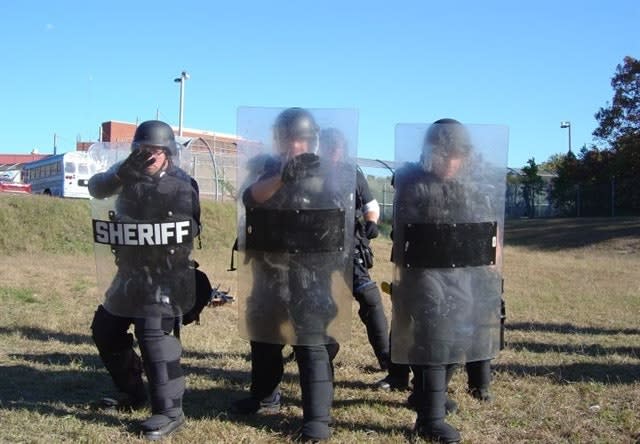To better understand the progression of thinking and police response in crowd management, let's take a look backward.
1920s Through 1940s
Riot lines of officers with little protective gear in the 1920s gave way to the use of chemical agents in the 1970s.

Photo courtesy of Dave Young.
To better understand the progression of thinking and police response in crowd management, let's take a look backward.
1920s Through 1940s
From about 1920 through the 1940s, there was no officially organized or structured response to small or large gatherings and mobs. Standard procedure was a riot line, which was 10 to 20 officers holding batons, axe handles, baseball bats, sticks, or clubs, usually with no other protection. There were usually three to four lines of officers, spaced 20 to 30 feet behind the other. The goal was to push back the crowd of people and/or disperse them. This usually ended up in a free-for-all after the line came into contact with the crowd. The goal of the riot line was to isolate, contain, or overpower the crowd by force. Officer injuries often occurred.
1950s Through Early 1960s
In the late 1950s, the first containment teams and standard squads using riot shields and batons were introduced. The idea was to use the shield squad to push the crowd back and protect the line. When the riot shield squad came into contact with the crowd, the baton squad was right behind it to assist in pushing the crowd back. When the baton and shield squads were confronted with deadly force, there was no preplanned, practiced, or rehearsed response. If deadly force was called for, basically every officer was on his own.
Late 1960s Through 1970s
In this period, CN and CS gas became common in crowd control, and riot squads became more defined.
However, when chemicals were used during a response, many officers were not trained or prepared to operate in a vision-impaired and/or oxygen-depleted environment, or even in how to operate in a protective mask. Officers were trained in control methods, but they were not tactically proficient in these techniques. The gear available to officers did not protect them from common injuries and was generally bulky, so it greatly restricted the officers' movements and was rarely used.
Related:
In the relentless heat of summer and even early fall in some parts of the country, officers face the important task of protecting their K-9 partners while working in sweltering temperatures. Recognizing changes in a dog’s behavior is the key.
Read More →ILEETA is a complete resource for trainers to address trainers' needs. Its mission is to enhance the skills and safety of criminal justice practitioners while fostering stronger and safer communities.
Read More →Technologies for improving law enforcement training and training management were some of the highlights at this year's show.
Read More →The 2024 pursuit-rated vehicles--all pickup trucks or SUVs, including two battery electric models the Chevrolet Blazer EV AWD and Ford Mustang Mach-E--were put through their paces.
Read More →As more alternative-fuel and hybrid vehicles hit the road, police and other first responders need to understand that they are no more dangerous than conventional vehicles. However, there are certain safety considerations every cop should know.
Read More →Garmont Tactical has found wide acceptance by military boot buyers, but now the company is trying to better respond to the needs of police officers. Many cops now are not fans of 8-inch boots, so Garmont is adapting.
Read More →Through our magazine and website and our Police Technology eXchange event, we promise to provide you with information and access to resources to help you do your job safer and better.
Read More →The Harris County Sheriff's Office is a model for other agencies that want to learn about crisis intervention and mental health crisis response. Sgt. Jose Gomez shares the story of their programs and provides 10 tips for mental health crisis call response
Read More →Mike Barham, of Galco Holsters, shares five important considerations to keep in mind when you buy off-duty concealed or plain-clothes carry holsters.
Read More →While the burden of accurately reporting use-of-force situations is on an individual deputy or officer, the person reviewing those reports shares in the responsibility of making sure the reporting is done properly, with clear details included.
Read More →